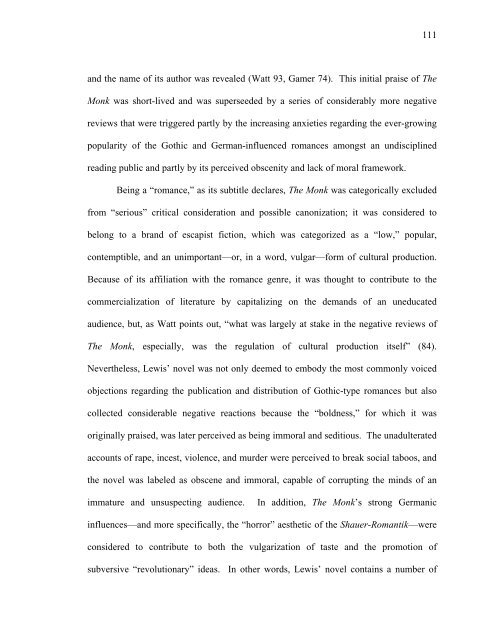Untitled - Sexey's School Moodle
Untitled - Sexey's School Moodle
Untitled - Sexey's School Moodle
Create successful ePaper yourself
Turn your PDF publications into a flip-book with our unique Google optimized e-Paper software.
and the name of its author was revealed (Watt 93, Gamer 74). This initial praise of The<br />
Monk was short-lived and was superseeded by a series of considerably more negative<br />
reviews that were triggered partly by the increasing anxieties regarding the ever-growing<br />
popularity of the Gothic and German-influenced romances amongst an undisciplined<br />
reading public and partly by its perceived obscenity and lack of moral framework.<br />
111<br />
Being a “romance,” as its subtitle declares, The Monk was categorically excluded<br />
from “serious” critical consideration and possible canonization; it was considered to<br />
belong to a brand of escapist fiction, which was categorized as a “low,” popular,<br />
contemptible, and an unimportant—or, in a word, vulgar—form of cultural production.<br />
Because of its affiliation with the romance genre, it was thought to contribute to the<br />
commercialization of literature by capitalizing on the demands of an uneducated<br />
audience, but, as Watt points out, “what was largely at stake in the negative reviews of<br />
The Monk, especially, was the regulation of cultural production itself” (84).<br />
Nevertheless, Lewis’ novel was not only deemed to embody the most commonly voiced<br />
objections regarding the publication and distribution of Gothic-type romances but also<br />
collected considerable negative reactions because the “boldness,” for which it was<br />
originally praised, was later perceived as being immoral and seditious. The unadulterated<br />
accounts of rape, incest, violence, and murder were perceived to break social taboos, and<br />
the novel was labeled as obscene and immoral, capable of corrupting the minds of an<br />
immature and unsuspecting audience. In addition, The Monk’s strong Germanic<br />
influences—and more specifically, the “horror” aesthetic of the Shauer-Romantik—were<br />
considered to contribute to both the vulgarization of taste and the promotion of<br />
subversive “revolutionary” ideas. In other words, Lewis’ novel contains a number of



